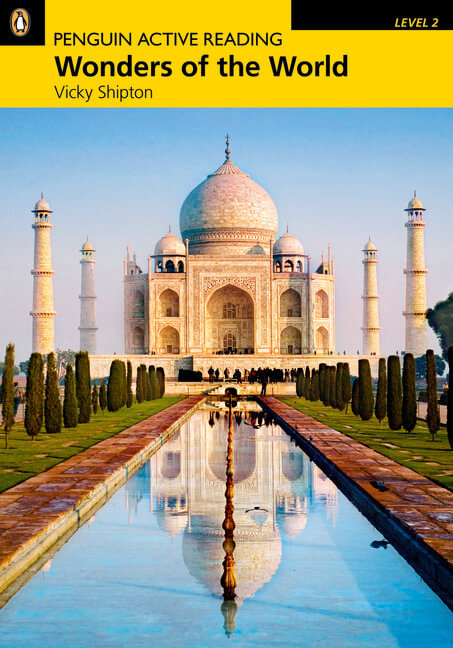Summary
Divided into six chapters, the book catalogues some of
the wonders of our world. We learn about the location,
physical dimensions, history and uses of man-made
ancient and modern constructions, and also about the
spectacular sights that nature herself has carved on the
landscape.
Chapter 1
A long time ago, the Greek writer Herodotus made a list
of the “Seven Wonders of the World.” From this list only
the Great Pyramid at Giza, Egypt, can be seen today, but
many other ancient wonders have survived including: the
Mayan city of Chichen Itza in Mexico which, apart from
its religious significance, was also the site of an extremely
dangerous ball game, the Great Wall of China, which at
one time stretched over 6,400 kilometers, and the city of
Petra and its famous temples, one of which featured in a
Hollywood movie. The Colosseum, in Rome, where men
and animals fought to the death, the Inca city of Machu
Picchu in Peru, the Parthenon in Athens, Stonehenge in
Britain and the Old City of Jerusalem are also mentioned.
Chapter 2
This chapter talks about the world’s wonders that are in
some way related to water. Famous bridges include the
Rialto, in Venice, London Bridge and the Golden Gate
Bridge in San Francisco. The Akashi-Kaikyo Bridge in
Japan, which opened in 1998, has the longest section of
any bridge in the world, and the Millau Bridge, in France,
is at one point 270 meters above the river. The Aswan
High Dam in Egypt is one example of a famous dam
and the Panama Canal is an example of a very important
waterway for world shipping, enabling shipping to sail
between the Pacific and Atlantic oceans without the need
to travel around the southern tip of South America.
Chapter 3
The world is full of important statues. The Moai Statues,
on Easter Island, number almost 900, and the Leshan
Buddha, in China, is the largest stone Buddha in the
world. Probably the most well-known is the Statue of
Liberty, followed by Christ the Redeemer in Brazil.
Islands, both natural and artificial, have a place in the list
of wonders. Venice was built on about 120 small islands
and has canals for streets, and the man-made island of
Kansai in Japan was built to accommodate an airport. In
Dubai, a region that suffers from land shortage, developers
have built islands in the sea to attract tourists.
Chapter 4
Throughout history, buildings have been constructed
to embody the religious or political power of the ruling
elite. The Forbidden City in Beijing housed twenty-four
Chinese leaders over six centuries, to the exclusion of most
of the rest of the population, and the Alhambra, in Spain,
was the seat of power of the Moorish rulers for over two
centuries. Since then, it has had many functions including
a resting place for Napoleon’s troops. The Taj Mahal, in
India, was built in honour of a ruler’s dead wife and the
Hagia Sophia, in Istanbul, was and is an important focal
point of Muslim, Christian and other religions. Angkor
Wat, in Cambodia, is now a Buddhist temple but was
originally constructed as a place of Hindu worship. The
Leaning Tower of Pisa, built by the Catholic Church, is
a famous tourist attraction in Italy and many people are
continually speculating as to whether it is going to fall
down or not.
Chapter 5
From the latter part of the nineteenth century onwards,
technological advances made possible the construction
of bigger and taller buildings. In 1889, the Eiffel Tower,
in Paris, was the tallest building in the world. It was
succeeded by the Empire State Building in 1931. This
building featured in the Hollywood movie, King Kong,
in which the huge ape stood at the top of it and fought
airplanes. There then followed a race to the top, with
countries competing to build the tallest building. The
Petronas Towers, the Sears Towers, the Burj Dubai were
contestants in this race. Not necessarily tall, but massive
in scale are the buildings at Beijing Airport and Crystal
Island, in Moscow, and the Sydney Opera House is noted
for its architectural beauty.
Chapter 6
The last chapter is dedicated to the world’s natural
wonders. The Grand Canyon, in the United States, and
the waterfalls of Iguazu, between Argentina and Brazil,
Angel Falls in Venezuela, and Victoria Falls, in Africa, are
truly remarkable examples of the work of nature. Mount
Fuji, Mount Kilimanjaro, the Matterhorn are world
famous mountains, each with their distinct qualities, but
the most famous of all, and the highest, is Mount Everest.
This mountain has claimed the lives of many climbers
who have tried to conquer it. Ayers Rock in Australia, a
sacred place for the indigenous Aborigine people, and the
Northern Lights are two further examples nature’s limitless
designs.





